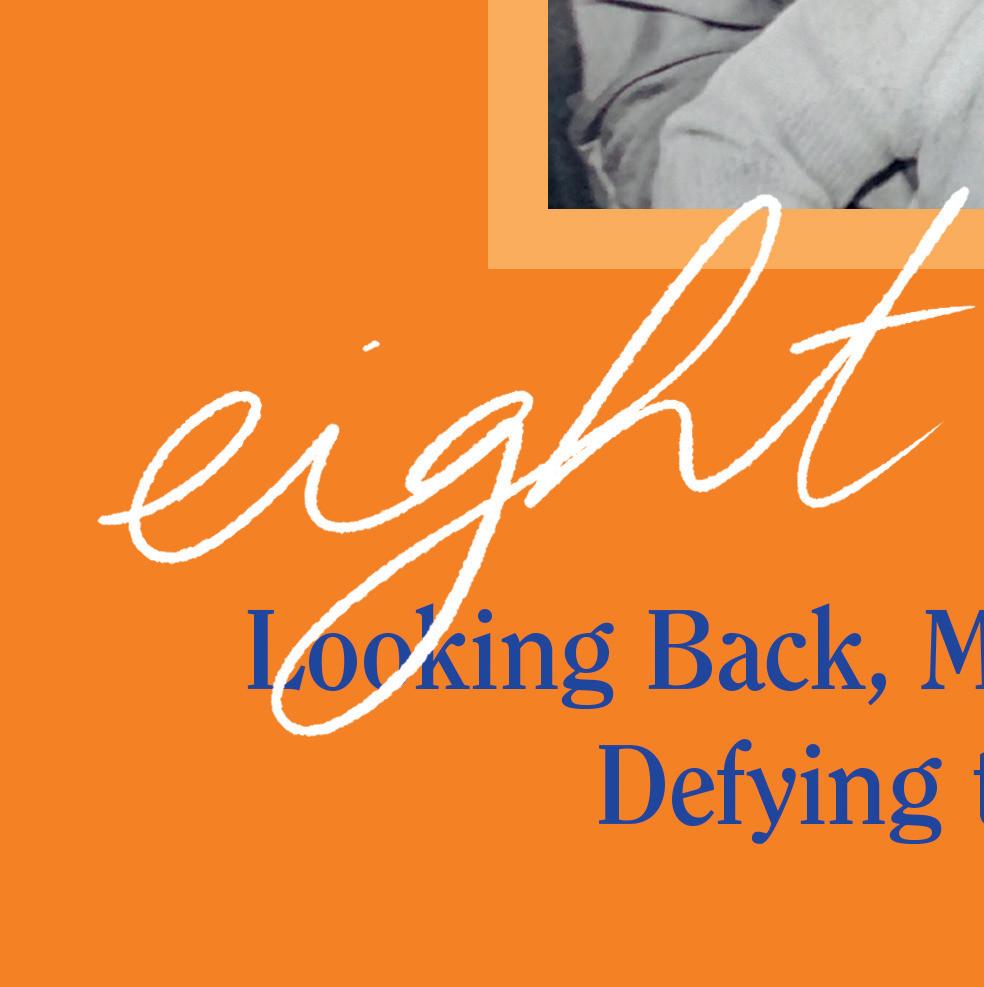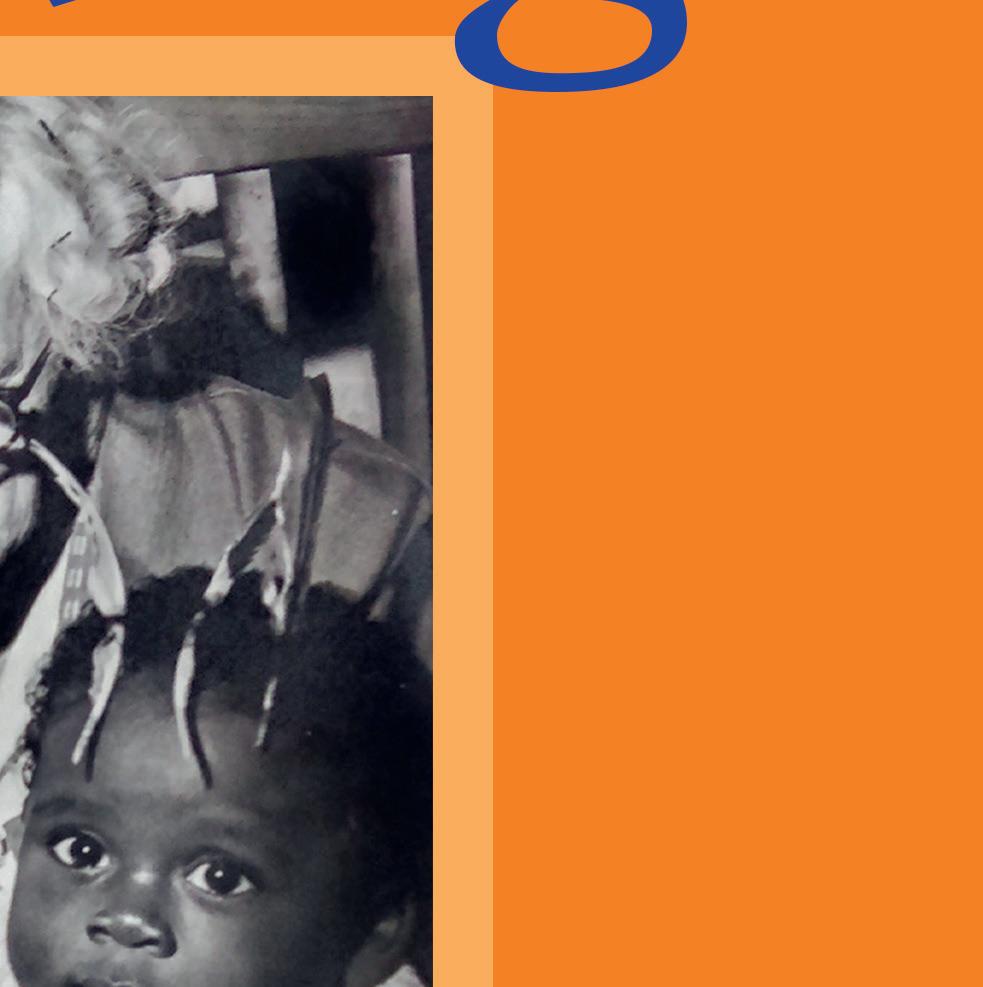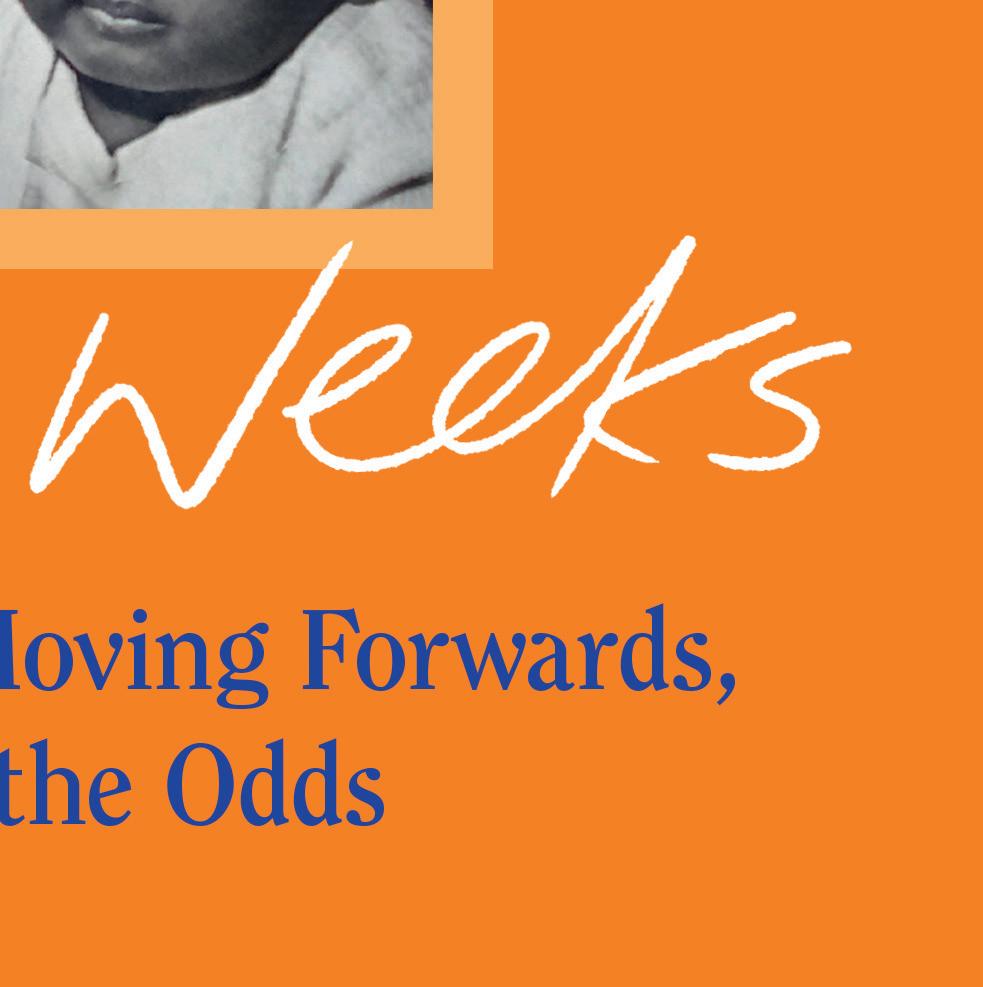


‘A remarkable journey, both personal and political, that few have travelled but all can relate to’ Gary Younge



‘I love Eight Weeks . . . I am in awe of the woman who grew from the child in this book’ Lemn Sissay





‘A remarkable journey, both personal and political, that few have travelled but all can relate to’ Gary Younge



‘I love Eight Weeks . . . I am in awe of the woman who grew from the child in this book’ Lemn Sissay


FIG TREE an imprint of
UK | USA | Canada | Ireland | Australia India | New Zealand | South Africa
Fig Tree is part of the Penguin Random House group of companies whose addresses can be found at global.penguinrandomhouse.com.
Penguin Random House UK , One Embassy Gardens, 8 Viaduct Gardens, London sw 11 7bw penguin.co.uk
First published 2024 001
Copyright © Baroness Lola Young, 2024
The moral right of the author has been asserted
Penguin Random House values and supports copyright. Copyright fuels creativity, encourages diverse voices, promotes freedom of expression and supports a vibrant culture. Thank you for purchasing an authorized edition of this book and for respecting intellectual property laws by not reproducing, scanning or distributing any part of it by any means without permission. You are supporting authors and enabling Penguin Random House to continue to publish books for everyone. No part of this book may be used or reproduced in any manner for the purpose of training artificial intelligence technologies or systems. In accordance with Article 4(3) of the DSM Directive 2019/790, Penguin Random House expressly reserves this work from the text and data mining exception
Set in 13.5/16pt Garamond MT Std Typeset by Jouve (UK ), Milton Keynes
Printed and bound in Great Britain by Clays Ltd, Elcograf S.p.A.
The authorized representative in the eea is Penguin Random House Ireland, Morrison Chambers, 32 Nassau Street, Dublin d 02 yh 68
A cip catalogue record for this book is available from the British Library isbn : 978–0–241–59063–8
Penguin Random House is committed to a sustainable future for our business, our readers and our planet. This book is made from Forest Stewardship Council® certified paper.
For all the others whose stories are yet to be told . . .
To write this book I’ve had to draw heavily on my powers of recall, and although I’ve done my best to be specific about dates and events, memory has its limitations. Apologies for any errors resulting from my attempts to reconstruct past events and my experience of them. Several names and locations have been changed or redacted for reasons that will, I’m sure, become clear.
8 August 1951, Miss Boardman : Foster mother states infant was received July 30th. Mother has entered hospital as a student nurse. Foster mother will come to Islington Welfare Centre. Infant having feeds of non-dairy milk.
There it sat, propped up on my desk in my office at The Chocolate Factory in Wood Green, north London. A hand-delivered A5 envelope with my name on it. No return address, and I didn’t recognize the handwriting. With no idea of what might be inside, I opened the envelope and shook out the contents – documents and photographs tumbled out in a heap.
I spread the items across my desk. Two passports: one the green of Nigeria, one British and blue. A second, smaller envelope. And a photograph of six women at what looked like a social gathering.
Both passports belonged to my mother, who had died in Lagos a year earlier, in 2005. The British passport had been issued in 1949, the Nigerian one in 1971; their covers had faded and were spotted with age. The second envelope contained an undated handwritten note comprising two sheets of A5 notepaper covered on both

sides with large, semi-legible handwriting, and was signed by a Chief Mrs Obafunke Akinkugbe. The name of the sender and the Lagos address meant nothing to me.
I looked more closely at the photograph. The light exposure made it seem as though the group of women were bathed in the warm rosy glow of a tropical sunset. Above one of the women’s heads was a little sticker with ‘Mother’ handwritten on it, and an arrow pointing down to her face, in case I couldn’t identify her unaided.
The envelope’s contents created a familiar anxiety. The fear that something of which I was ignorant, and would like to remain so, would be revealed. Something that would disturb the life I was currently enjoying, two years into my appointment to the House of Lords.
I delayed a thorough reading of Chief Akinkugbe’s letter for as long as possible, first studying the passports that outlined a story of journeys undertaken, and a life lived unfamiliar to me. I couldn’t make sense of a series of visas for trips outside Nigeria, but not to the UK , stamped on the blotchy pages of the green and blue booklets. I stared at the little portrait photograph in each. My mother. I had never owned a photograph of her, and I tried to match the woman in the photos with the facial features buried a mile deep in my memory. Was it vain of me to want to see if I was reflected in my mother’s eyes, her cheekbones, the shape of her jaw? I searched her face, her expression, trying to read who she was, get a sense of her character, but her half-smile gave nothing away. There she was, bejewelled and gazing at the photographer, bottles of Coca-Cola and a 7Up waiting on the table. I had no idea who the other women seated with her in the group photograph were. I turned my attention back to the handwritten note. It contained a brief sketch of the years my mother had spent in London just before I was born. Some of the names mentioned were hazily familiar, others were not known to me. Williams, Adekunle, Makanju, Young, Santos. Place names jumped out too – Earl’s Court, Osogbo, Lagos, Aldershot, Leyton and Epping Forest – emphasizing a connection between Nigeria and England, Lagos and London.
Over the decades, I’d been fed scraps of information about the past. Dribs and drabs culled from random, unverified sources passed on to me by distant relatives.
Unexpected visits of wealthy Nigerians had punctuated my life from around the 1970s; they would come to London to stay in their apartments in well-to-do areas like Marble Arch, St John’s Wood, Chelsea and Hampstead, or to stay in posh central London hotels. They’d pass me slivers of information and, if I was lucky, a tenpound note, then off they’d go, seldom to be seen again. Almost inevitably, the most recent tale told would contradict the previous one in some aspect.
Chief Akinkugbe’s letter did little to clarify the picture. The choppy phrases, the names and dates dropped in without elaboration, had the feel of someone taking notes over the phone while the person on the other end of the line told a jagged story. As I read it, I imagined her standing in her kitchen, phone receiver nestled between her chin and her shoulder as she searched for a pen and notepad.
I couldn’t help feeling a pang of frustration when I came to the end of the note. The unspoken promise of the package was that I’d find answers, if I could only fit the pieces together, but my expectations had been raised only to be let down with a jolt. Yet another incomplete story, which left me with the questions that had haunted me throughout my life: how had my parents met? How had I come into being? And why hadn’t they wanted me? Perhaps it was pointless to try and revive that painful history. Even though in the past I’d sought answers, finding out the truth about why my mother and father had acted in the way they did was a task for which I had little appetite. In my professional life, the desire to know
as much as possible, to see the full picture, had always been an important driver for me. But in the matter of my family history, that compulsion to know was a source of upsetting, contradictory feelings.
What I knew about my parents was this: my mother, Yele Santos, was a widow with two sons living in Lagos when she began a relationship with my father, Maxwell Young. I don’t know when but I would guess around the late 1940s, after her husband died in 1944. Yele and Maxwell agreed that she would travel to London to train as a nurse and wait for my father to join her. He was also coming to the UK capital with the aim of studying microbiology. Reunited with Maxwell in west London, Yele became pregnant with me – and found out that my father had already married someone else in Nigeria. Maxwell had a wife and a daughter who was two years old when I was born. The daughter’s name was Shade. I was born on 1 June 1951 in St Mary’s Hospital, Paddington. Six weeks later I was handed over into the care of Daisy Vince, a registered foster mother in her late sixties who had looked after many children over the years. I had no idea at the time, of course, but I would end up staying with her until I was fourteen years old. Throughout my early childhood at Daisy’s house in Tufnell Park, each of my parents came to visit me, independently of the other, on a handful of occasions. By the time I was twelve years old, both Yele and Maxwell had returned to Lagos to live their separate lives, and I would not see either of them again until many years
later, when I was an adult. My father had a stroke and died in June 1994, and I learned of my mother’s death through a circuitous route involving Shade and other, previously unknown, relatives in 2005.
Over the days and weeks that followed, I tried to put the envelope and its contents to the back of my mind, and focused instead on my still relatively new position as a member of the House of Lords.
There had been so much for me to learn since my introduction ceremony in July 2004. I was one of the beneficiaries of the Labour government’s reforms of the House of Lords: as well as cutting down the number of hereditary peers, the idea of so-called ‘people’s peers’ was established, enabling those with no party political affiliation to become part of the country’s law-making machinery. Entering the House of Lords by this route entailed applying, and being interviewed several times, and eventually vetted. The process was long and similar to that of the appointment of a chief executive at a large, well-known organization. As with those roles, you might be approached and asked to apply, or you might take the initiative and apply yourself. Encouraged by friends and colleagues, I applied and was accepted the second time around.
As members of the House of Lords (or peers, as we’re often called), we aren’t employed by Parliament or anyone else, and, unlike MP s, we’re not paid a salary, but we may receive an attendance allowance. It had been made clear to me that our main task was to scrutinize
legislation, but the number of hours I dedicated to the role, and the frequency with which I should attend parliamentary sittings, were left to me. As an independent crossbench peer, unlike those members who belonged to a political party, I was not subject to the discipline of a party whip. When I first started, several peers advised me not to make being a member the centre of my life, while others suggested I should simply observe how everything worked for a while, to orientate myself. I followed both pieces of advice.
As well as getting to grips with the rituals and procedures, I had to find my way around the building. Easier said than done for someone with my poor sense of direction. There are miles of passageways in the Palace of Westminster, in which the Houses of Parliament sit, and there are more staircases than you’d like when you’re late for a vote and the lift is slow. There are over a thousand rooms too.
I joined the House with no legal training, and no experience in party political machinations, so there was a lot to absorb. While I’d always been an avid reader, I’d had to learn that skill all over again when scrutinizing new legislation proposed in bills, or the proceedings of a select committee. If I wanted to play an active role in Parliament, developing legislative literacy would be essential.
During my first two years in the House I’d been surprised by the number of bills proposed by the government to which I’d felt a connection. I’d assumed there would be few opportunities to contribute, initially,
but both the Human Tissue Act (2004), which provoked heated debates about the transfer of human remains from museum collections, and the Children Act (also 2004), establishing the role of the Children’s Commissioner, related to different areas in which I had an interest. I’d assumed that my experiences would lead me to get involved in laws relating to children, families and the care system. But I hadn’t imagined that my background in the cultural and creative industries – I’d set up an arts and culture consultancy in 2004, served as Head of Culture at the Greater London Authority, sat on the boards of trustees of the National Theatre and the National Archives, and chaired judging panels of literary prizes – would also prove relevant quite so quickly. Debates about the status of human remains in museum collections took place both in the sector and in Parliament.
While I’d long been interested in the relationship between political activity, cultural and creative practice and cultural theory, my participation in the Lords signified a new level of political engagement and understanding, underpinning the campaigning and activism in which I’d been involved before my appointment.
Despite my best efforts to remain focused on my work, the contents of the envelope kept calling to me while they awaited my return. I pored over the writing and the images, seeing something new each time.
Shortly after I was introduced to the House of Lords, an elderly fellow crossbench peer quoted an old saying
containing a truly offensive racial slur, in my presence. Difficult though it might be to believe, I think he had been trying to make me feel welcome by ‘joking’ with me. I recalled this incident as I continued my study of the contents of the package. Trying to fill the gaps in my knowledge of my parents’ lives with only the outline of a narrative before me, I wondered how, back in the 1950s, each of us had coped with similar racist insults – they as adults and me as a child.
On a phone call with my friend Sally, I brought up the subject of the package and its contents. Sal and I had been at Parliament Hill Comprehensive School together from 1962 to 1969. She was one of three lifelong friends I had made during those years – Sally, Jo and Anne. We were the self-styled ‘Parlets’, still friends more than six decades later.
I told Sal how frustrating it was to have been sent a tantalizingly small part of the whole picture.
‘You do know you’re entitled to see the records from your time in care, don’t you, Lo?’ she said.
I was stunned. I had never considered there was such a possibility.
‘The council are legally obliged to share them with you. Get on to Islington and see what they have.’
‘Seriously?’ I tried to take in the implications of what Sal was saying. How had I not known about this before?
In the years that followed our conversation, I would learn that my experience was not uncommon. It was the 1989 Children Act that enshrined the right of anyone who’d spent time in the care system to access their
records. A laudable decision, but making sure that everybody affected by the law was aware of their rights was another matter. There are those who still do not know about it – I’ve met care experienced people in their fifties and sixties who had no idea that it was their right to access their case notes.
‘It may not be straightforward, given the time that’s passed,’ Sal continued. ‘The files could have been lost or destroyed. And, even if you find them, names and events may be heavily redacted. Also, bear in mind that you were in care in the fifties and sixties – some of the language they used then would be totally unacceptable today, especially around race.’
I smiled wryly to myself as I thought of the elderly peer who had obviously not received the memo on that subject.
After a pause, Sal said, ‘To be honest, the chances of you finding anything from that period are pretty remote. When I was still working for Islington, a room where old files were stored was flooded by a leaky washing machine in the flat above.’
Thinking about all those lost histories saddened me, and I wondered if my past had floated away on a tide of scummy grey water. I considered Sal’s remarks: the social workers I’d encountered would have had no idea that one day I’d be reading what they’d written about me. Later I would learn that some of them deliberately destroyed care records, believing that to do so enabled care leavers to move on with their lives. They might have thought it an act of kindness, but I see it as woefully
misguided, an abuse of power. These historic missteps in keeping children’s care records safe meant that I needed to manage my expectations about what I might be able to find.
The reality was that the prospect of me finding anything at all, let alone something that could resolve my feelings about my history and my parents, was as distant as ever.
‘It’s still worth a try though, Lo.’
Sal was right. For as long as there was even a faint possibility that I might find a record of my life in care, I couldn’t ignore it. I had to follow the trail. We hung up and I was left with doubts and anxieties. What if there was something truly disturbing in those notes – something I’d forgotten about? Or had never known? I had few photographs of myself before the age of about twentyfour, so it wasn’t difficult to pretend childhood had bypassed me altogether. Would it be better or worse if there was no record at all of Lola Young’s experiences as a child?
Over thirty-five years had passed since I’d left the care of the London Borough of Islington. A part of me felt fortunate that I hadn’t experienced the abuse that others have had to endure in their childhood and adolescence, and I was also aware that having had a degree of stability early on in my life was helpful. But the idea that I had somehow been lucky was not apparent to me as a child, or a teenager; I’d viewed myself as unwanted and unlikeable.
In the interests of completeness, I wanted to know
the missing details that might help explain the absence of parents in my life. Without that knowledge I realized I wouldn’t be able to make sense of the random collection of puzzle pieces I’d been sent from Lagos, along with the snippets I’d collected over the years. What was more, since the 1980s, with the discovery that the presence of Black people in Britain could be traced back to Roman times, I’d come to appreciate the importance of our individual and collective histories. As far as possible, I needed the whole picture, because whether I chose to engage with it or not, my past experiences had shaped the woman I had become. The arrival of the mystery package had stirred up old hurts, that was obvious, but perhaps there would be some resolution – even some comfort – in discovering why my parents had left me behind in London.
20 July 1952, Miss Boardman : Well & happy. Has won a prize at a baby show recently.
1 November 1956 : Bright child. Likes attending school. Has never been a miserable child but has until recently been rather solemn.
Sal’s revelation about the care records should have spurred me to action straight away, but something held me back. I needed to think through how I would feel if my detective work came to nothing. Best to spread it out over time so as not to make the process too intensive; I mustn’t over- invest in the search to the detriment of other parts of my life. After all, I’d managed to get this far without even knowing that the records existed.
So it was some months after my phone conversation with Sal that I contacted Islington Council by email, giving them details of my time spent in the care system. Their first reply took several weeks to arrive and indicated that this was not going to be a straightforward search because of the length of time that had elapsed. I’d told them of the period I’d spent in children’s homes
outside London and they responded that I should approach the local authorities responsible for those areas – Hertfordshire and Middlesex.
No, I said, these were Islington Council-owned homes.
No, they said, Islington didn’t have children’s homes outside London.
Yes, I said, they did and I’d lived in them.
Check with London Metropolitan Archives, they insisted. They’ll have the records for Hertfordshire and Middlesex.
I knew what I’d experienced, and I knew what I remembered, but just to be sure I wasn’t somehow mistaken about all the different places I’d lived in, or how the system worked, I emailed London Metropolitan Archives and I asked if they had records from that era relating to the care system.
No.
Of course they didn’t, I thought. You should try the London Borough of Islington, they said . . .
With my expectations raised and then dashed to the ground, I took the decision to put my quest on hold again. It was an emotionally draining situation and I had more than enough to keep me occupied working out how I could make a positive contribution in the House of Lords.
When I look back on those early years in Parliament, it’s clear that my childhood experiences played a part in how and why I involved myself in particular issues. Now
that I had a platform from which to persuade and cajole, to influence, I focused on who was likely to miss out as a result of passing a given piece of legislation, accepting the findings of a committee report or policy paper. I threw myself into my cultural consultancy business at the same time as building a presence in Parliament, taking on contracts that exposed the inequalities embedded in the way systems were built, and proposed how to address them.
Between 2004 and 2011, I was involved in select committees, spoke on topics such as the abolition of the transatlantic trade in enslaved Africans, and co-produced an event to mark its bicentenary; I founded an All Party Parliamentary Group on Ethics and Sustainability in Fashion, the first of its kind, before sustainability became more or less mainstream; I visited schools, giving talks; I contributed to a new law that criminalized forced labour and domestic servitude; I spoke at academic, policybased and political conferences and seminars, and worked with cultural practitioners and theorists, as well as parliamentarians in the UK and around the world. It was a busy, productive period.
Through postgraduate study, which I’d loved, I’d gained critical and analytical skills, and I now found the act of linking theory, practice, policy and politics a challenging and exciting environment in which to work. That thrill connected with my love of reading and writing, the joy of which has remained with me from my first years at school. The various aspects of my working life were beginning to click together, enabling me to
maximize impact; what I learned outside Parliament reinforced what I learned inside the institution, and vice versa.
While I was thinking about the politics of culture (and the culture of the political sphere), every now and then a stray thought about the search for my care notes would pop into my head. At this very moment, they might be lying under a pile of tatty folders in a rusty filing cabinet at the back of some forgotten Islington office along the Holloway Road, waiting to be revealed. I had to set aside my initial disappointment at not receiving the records as soon as I asked for them, and be more realistic. I would restart the hunt, and if I couldn’t find them after a sustained, determined search, then I’d forget all about it and be no worse off.
On a friend’s recommendation, I contacted the Care Leavers’ Association (CLA ), a Manchester-based organization that supports care experienced people when they leave the system. I told the CLA the story of my search so far, and they advised me to go back to Islington Council. They gave me some pointers on how to formulate my request.
So it was that after a few brief introductory email exchanges, on 5 August 2011 – some five years after I’d first learned about care records – I received the following email.
Dear Ms Young,
Thank you for your prompt response in sending the completed access to records application to me. I regret
to inform you that we are currently operating with a significant backlog. It is therefore necessary to place your application on our waiting list before being processed. Your application has been entered at number 35 on our waiting list.
The access to records process involves locating any relevant files, reading through these files in detail, contacting family or professionals who have contributed to the files in order to obtain their consent to share their information with you, and finally making a copy of the files for you. We recommend that applicants attend our office to collect their copies – you are welcome to bring a support worker or friend with you if you wish to read through the files in our offices.
Alternatively we can arrange for files to be sent via recorded delivery mail but we encourage applicants to have support networks in place as reading through these files can be a difficult experience.
I will be in contact to advise you whether we have located any files regarding you, and will endeavour at this point to give you an estimate of completion time.
If you have any queries or concerns in the meantime, or you would like an update on the progress of your application, please feel free to contact me using the details below.
Kind regards,
Access to Records Officer Children’s Social Care Islington Council
Given that I had been number 36,000 on the waiting list for an Arsenal season ticket, I thought my patience would stretch to however long it took for Islington’s bureaucratic wheels to turn.
I thought endlessly about what the records – should they ever turn up – might contain. Would they match my earliest memories? Would I need to think of a different way of telling that story? However many gaps and absences there’d been in telling others about my childhood to date, I’d always felt confident about what I did know: where and how certain events had taken place, my age at the time of a specific incident. Now I had to face the possibility that while everything I thought I knew might be confirmed, it might equally be turned on its head.
Daisy Vince, the white foster mother I would grow up calling ‘Mum’, was nearly sixty-five years old when my parents handed me over to her. As I grew up in her care, Daisy would tell me many times that I was just six weeks old when I arrived at 207 Tufnell Park Road. I knew this pronouncement must be significant, because of the number of times she repeated the story, but it was also meaningless, for what does a five or six year old know about being any age other than the one they are at that particular moment?
The imposing Victorian terrace in which we lived stood on the corner of Tufnell Park Road and Huddlestone Road, in north London. One flight of steps led down to the basement, and another led up to the main front door
over which, printed on glass, was the word ‘Stalheim’. Somebody told us it was a German word meaning prison, but I later discovered it was the name of a village in Norway. The four-storey house belonged to Daisy’s family and was divided into separate flats. Daisy lived in the basement occupying four rooms, and on the elevated ground floor lived two middle-aged single women. The rest of the house was occupied by Daisy’s daughter, granddaughter, and eventually great-grandchildren.
Our flat had direct access to the garden, and was made up of a kitchen, a front or living room, one bedroom and a scullery. Daisy and all of us who were fostered by her slept in the same bedroom.
Daisy told us she was a widow and that her husband had died in the war: I was about ten when she let this slip and it didn’t occur to me to enquire about the name of her spouse, or to which war she was referring. Several decades later, thanks to a friend who was interested in genealogy, I found out that the truth was rather more complicated than Daisy’s simple statement suggested, but I’ll come to that later. For the moment it’s enough to say that Daisy Vince was the birth mother of Evelyn, who lived on the second floor with her husband, Liam Flanagan. By the time I arrived on the scene, in the summer of 1951, Evelyn was in her mid-forties. Evelyn and Liam had a daughter, Julie, who lived on the top floor with her husband, Terry Andrews. They were married in 1954; I was three years old and wore a red ‘siren suit’ (as the all-in-one hooded outer garment was called then) to the wedding. That’s my earliest memory. I was
captivated by the confetti that fell like snow and covered the bride, the groom and the pavement outside the church.
As a registered foster mother, Daisy Vince was well known and trusted by what was then London County Council authorities. She was also one of the few in the area who would take in Black children. When my mother and father turned up at her door in the summer of 1951, she had been fostering for several years. Some children would stay for a few months; others spent their entire childhoods with Daisy and only left when they moved into rented accommodation or married. I wonder whether they were curious about where they’d come from, or whether they simply knew enough to be grateful that they’d ended up with Daisy Vince. I have vivid memories of Jack and Sidney, in particular, as they returned to Tufnell Park Road every year for Christmas lunch. Sidney would blink rapidly for several seconds, a kind of nervous tick, though he was always fun, cracking jokes, indulged by everyone when he expressed what were then considered outlandish ideas such as vegetarianism and yoga. Jack was rather more strait-laced and conventional, handsome in a distant movie star sort of way. He too was fun and was a willing Father Christmas year after year. Sidney and his wife, Jeanette, and Jack and Gillian with their son, Oliver, came laden with presents, and without them Christmas would have had a very different feel.
Tufnell Park Road was long and straight and led to Holloway Road, the main shopping area, with the
department stores Jones Brothers and James Selby. The neighbourhood around Tufnell Park, Archway and Kentish Town marked our geographical boundaries, with an occasional foray into Camden Town or Parliament Hill Fields. Daisy was well known in the area, most likely due to always having various children or babies in tow. Local shop owners would greet her in the street, as would the police officer on his beat. The pet shop on Junction Road was a regular haunt, and the back-street route to it took us past a railway line. As kids we loved waving at the trains as they approached and tooted, steam billowing behind the engine as it caught in the wind. If we were lucky, a passenger would spot us and wave back, their acknowledgement curiously thrilling.
Tufnell Park wasn’t posh, but it did have an air of quiet gentility. Nonetheless, notoriety wasn’t far away. Holloway Women’s Prison, its castellations giving it the air of a fairy-tale medieval castle, was burdened with the horrors of incarceration and hangings. Nearby, its male counterpart, Pentonville, stood behind a deceptively bland wall on Caledonian Road. To complete this triangle of criminality, the former home of an infamous killer, cloaked in ordinariness, was located between the two prisons. I have a vivid recollection of my primary school head teacher regaling Daisy and me with the story of how she’d refused to let her school be named after nearby Hilldrop Crescent because of its association with the murderous Dr Crippen. Perhaps growing up with all this talk of crime influenced my choice of reading. I always preferred thrilling tales about the
adventures of intelligent, brave detectives – usually male, but not always – to the stories of girls who played lacrosse and ate midnight feasts in boarding schools.
When I first arrived at Tufnell Park Road, there were two other children being looked after by Daisy: Richie and Lynne. Even without a photograph to refer to, I can still recall Richie’s features in my mind’s eye. Describing what he looked like to someone else is more difficult. He was just a boy – older, bigger and stronger than me; sometimes an amiable joker but just as often my tormentor. When I look now at a photograph from about 1956, I can see a sadness in his eyes that matched my own. Or perhaps it was a wistfulness, a yearning to be someone and somewhere else. He would run away on several occasions from the boarding institution in Stony Stratford where he’d been sent after some escapade or other. Eventually we managed a peace of sorts, though our relationship couldn’t really be characterized as a close friendship. Richie had been with Daisy since he was a baby; only Lynne had lived with Daisy for longer. She would have been in her early teens as I started primary school. Sleeping in a cot, I joined Richie, Lynne and Daisy in the bedroom in the cool, north-facing rooms in the basement. I called Daisy ‘Mum’. I knew she wasn’t my mother, of course, but I tried not to think about that complicated situation too much. Lynne and Richie also called Daisy ‘Mum’, and this made it feel normal.
Bath night was a palaver and took place about once every two weeks. Daisy would fill two big saucepans, a